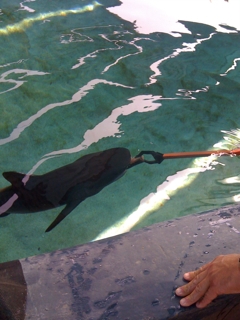Source (google.com.pk)
Facts About Tiger Sharks For Kids Biography
Tiger Shark (Galeocerdo cuvier)
What does it look like?
Image © Janet Mann
“The space between its two eyes was 20 inches, and 18 inches from one corner of his mouth to the other. Its Maw [stomach] was like a leather sack, very thick and so tough that a sharp knife could not cut it. In which we found the Head and Bones of a Hippopotamus…,” wrote William Dampier, who explored Shark Bay in 1699. Although the “hippopotamus” was actually a dugong, there is little doubt that the shark that ate it, and that Dampier caught, was a tiger shark.
Shark Bay boasts one of the world’s largest populations of tiger sharks. An adult fish can measure from 4 – 6.5 m long and weigh 520 kg! Its broad, blunt snout contains strongly curved teeth, and its angular, ‘hooked’ tail allows it to twist and turn rapidly to catch fast prey. The handsome stripes down its back are darker in younger fish, growing fainter or even absent in large adults, which tend to be plain grey.
Where does it live?
The tiger shark inhabits inshore waters, deeper offshore areas and reefs. The top predator in the marine ecosystem, in Shark Bay it is most active during the day and most common during the summer months, when the water is warmer and its main prey, sea snakes and dugongs, are more plentiful. Green turtles and smaller sharks and rays are also favoured foods.
The tiger shark has a large brain and a sophisticated sensory system, including excellent eyesight, taste and smell. Receptors along its sides can detect vibrations and water pressure changes – useful for targeting prey at mid-range – while special pores in its snout detect the weak, close-range electrical fields generated by the muscles of its prey. The shark can even find rays buried in the sandy sea floor! Judging by the strength of the signals, the shark can work out if its target is healthy or wounded, and decide whether to go in for the kill.
How does it breed?
In some ways sharks have more in common with whales and dolphins than they do with other fish. They grow slowly, mature at an older age, and produce relatively fewer young. Whereas females of most fish species eject thousands (sometimes millions!) of tiny eggs, to be fertilised outside the body by males, female sharks produce fewer, larger eggs that are fertilised inside their body. Males use their sexual organs, known as claspers, to deliver sperm to the female. After about nine months pregnancy the tiger shark gives birth to up to 60 young, called pups.
Any threats to its survival?
Some shark species live up to fifty years, and because they breed only every two years or so they are vulnerable to over-fishing. Often portrayed as vicious killers, they are more threatened by humans than humans are by them. Many sharks are slaughtered out of fear or hate. Others are killed for sport, food and other resources. For example, shark liver is used in products as varied as vitamin supplements, paint base, cosmetics and lubricants! Many sharks die when they are trapped in nets set for other fish species.
The tiger shark is not a threatened species but several other sharks are, including the grey nurse shark, which also lives in Shark Bay.
Is it dangerous?
In Shark Bay the tiger shark has plenty of food, and since humans are not on the menu it’s extremely unlikely you will be eaten! Nevertheless, the tiger shark does patrol coastal waters and should be considered dangerous.

Facts About Tiger Sharks For Kids

Facts About Tiger Sharks For Kids

Facts About Tiger Sharks For Kids

Facts About Tiger Sharks For Kids

Facts About Tiger Sharks For Kids

Facts About Tiger Sharks For Kids

Facts About Tiger Sharks For Kids

Facts About Tiger Sharks For Kids

Facts About Tiger Sharks For Kids
Facts About Tiger Sharks For Kids Biography
Tiger Shark (Galeocerdo cuvier)
What does it look like?
Image © Janet Mann
“The space between its two eyes was 20 inches, and 18 inches from one corner of his mouth to the other. Its Maw [stomach] was like a leather sack, very thick and so tough that a sharp knife could not cut it. In which we found the Head and Bones of a Hippopotamus…,” wrote William Dampier, who explored Shark Bay in 1699. Although the “hippopotamus” was actually a dugong, there is little doubt that the shark that ate it, and that Dampier caught, was a tiger shark.
Shark Bay boasts one of the world’s largest populations of tiger sharks. An adult fish can measure from 4 – 6.5 m long and weigh 520 kg! Its broad, blunt snout contains strongly curved teeth, and its angular, ‘hooked’ tail allows it to twist and turn rapidly to catch fast prey. The handsome stripes down its back are darker in younger fish, growing fainter or even absent in large adults, which tend to be plain grey.
Where does it live?
The tiger shark inhabits inshore waters, deeper offshore areas and reefs. The top predator in the marine ecosystem, in Shark Bay it is most active during the day and most common during the summer months, when the water is warmer and its main prey, sea snakes and dugongs, are more plentiful. Green turtles and smaller sharks and rays are also favoured foods.
The tiger shark has a large brain and a sophisticated sensory system, including excellent eyesight, taste and smell. Receptors along its sides can detect vibrations and water pressure changes – useful for targeting prey at mid-range – while special pores in its snout detect the weak, close-range electrical fields generated by the muscles of its prey. The shark can even find rays buried in the sandy sea floor! Judging by the strength of the signals, the shark can work out if its target is healthy or wounded, and decide whether to go in for the kill.
How does it breed?
In some ways sharks have more in common with whales and dolphins than they do with other fish. They grow slowly, mature at an older age, and produce relatively fewer young. Whereas females of most fish species eject thousands (sometimes millions!) of tiny eggs, to be fertilised outside the body by males, female sharks produce fewer, larger eggs that are fertilised inside their body. Males use their sexual organs, known as claspers, to deliver sperm to the female. After about nine months pregnancy the tiger shark gives birth to up to 60 young, called pups.
Any threats to its survival?
Some shark species live up to fifty years, and because they breed only every two years or so they are vulnerable to over-fishing. Often portrayed as vicious killers, they are more threatened by humans than humans are by them. Many sharks are slaughtered out of fear or hate. Others are killed for sport, food and other resources. For example, shark liver is used in products as varied as vitamin supplements, paint base, cosmetics and lubricants! Many sharks die when they are trapped in nets set for other fish species.
The tiger shark is not a threatened species but several other sharks are, including the grey nurse shark, which also lives in Shark Bay.
Is it dangerous?
In Shark Bay the tiger shark has plenty of food, and since humans are not on the menu it’s extremely unlikely you will be eaten! Nevertheless, the tiger shark does patrol coastal waters and should be considered dangerous.
Facts About Tiger Sharks For Kids

Facts About Tiger Sharks For Kids

Facts About Tiger Sharks For Kids

Facts About Tiger Sharks For Kids

Facts About Tiger Sharks For Kids

Facts About Tiger Sharks For Kids

Facts About Tiger Sharks For Kids

Facts About Tiger Sharks For Kids

Facts About Tiger Sharks For Kids
Facts About Tiger Sharks For Kids

No comments:
Post a Comment